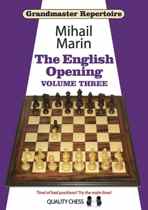English Opening, The — Volume 3
Mihail Marin

The third volume in the series, The English Opening: Volume Three by Mihail Marin, covers the Symmetrical variation of the English, but with a move-order that avoids the Hedgehog and Double fianchetto variations and the heavily analyzed Four Knight English with an early d4.
Over half of this book is devoted to 1.c4 c5 2.g3 g6 3.Bg2 Bg7 4.Nc3 Nc6 5.Nc3 with the core the English/Kings Indian line 5…Nf6 6.d4 cxd4 7.Nxd4 0-0 8.0-0 Nxd4 9.Qxd4 d6 10.Qd3 where Marin has found a most interesting novelty in 10…a6 11.Be3 Ng4 12.Bd4 Ne5 13.Qe4!
The reversed Maroczy-Bind line has a reputation of being a very tough nut to crack and the main lines after 1.c4 c5 2.g3 Nf6 3.Bg2 Nc6 4.Nf3 d5 5.cxd5 Nxd5 6.Nc3 Nc7 7.0-0 e5 involving d3 followed by Nf3-d2-c4 have White showing a hard time showing any advantage at all. Once again Marin has brought a fresh approach to the problem and advocates 8.a3 intending dynamic play with b2-b4 and e2-e3 followed by d2-d4 attacking the pillars of the bind.
The Kings Indian and Dutch are often mentioned as universal defenses against everything but 1.e4, but Black has a third all-purpose answer to queenside openings in the Tarrasch Defense. Again this is not an easy opening to show a clear advantage against and the typical isolated queen pawn positions are not common for the English. Marins answer is what he calls the Anti Tarrasch Catalan (1.c4 c5 2.g3 Nf6 3.Bg2 e6 4.Nf3 Be7 5.0-0 0-0 6.d4 d5 7.dxc5 where after 7…Bxc5 8.a3 White plays against the Bishop on c8).
1 The Double English A Repertoire 11 The Closed System 2 Introduction and Sidelines 15 3 5...d6 27 4 5…e5 51 5 5…e6 The Fischer System 79 6 5…Nf6 101 7 Main Line with 8…Nxd4 123 The Open Lines 8 2…Nf6 149 9 The Reversed Maroczy 165 10 Reversed Maroczy with ...g6 195 The Flexible 3…e6 11 Introduction 215 12 4…b6 The Inferior Queens Indian 219 13 4…a6 The Inferior Hedgehog 229 14 The Anti Tarrasch Catalan 209 15 6…cxd4 The delayed Hedgehog and others 215
One of the virtues of the repertoire that Marin has constructed is that it can be a stand alone system or parts of it can be used selectively by those who open 1.Nf3. Players below 2400 FIDE will likely adopt it in full but stronger players may choose bits and pieces combining it with other lines for example the Fianchetto Variation against the Kings Indian and Grunfeld and in this they will be well-served by the second volume in GM Avrukhs series on 1.d4, also published by Quality Chess.
Volumes two and three in Marins series on the English are published on high quality paper with a clean, easy to read layout. They are available in both hardback and paperback editions with the former costing 8 Euros more. This might seem like an unnecessary luxury for an opening book that will eventually be outdated. However, if your budget allows and you intend to use these books a lot, it might be a wise investment. Will the difference in price be remembered after you have spent several hundred hours mastering this material?
I give Marins three volumes series on the English my highest recommendation.
Also check out the reviews for The English Opening Volume 1 and The English Opening Volume 2.
